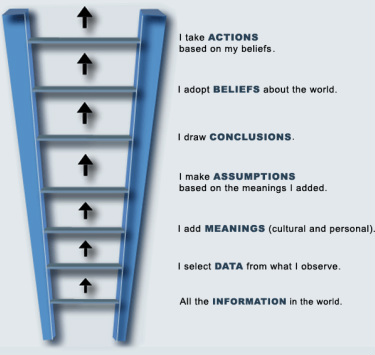When I work with clients on navigating any significant change effort one of the first set of questions I ask them is, "Why change? And why now?". Organizations sometimes rush to alter systems, structures or strategy to solve problems or take advantage of perceived opportunities. All too often, though, assumptions - often untested - influence leaders to enact change that doesn't stick, or worse, change that creates even more problems or internal turmoil.
Organizational behavior theorist Chris Argyris demonstrated this phenomenon when he created his Ladder of Inference model. In it he demonstrated how we live in a world of self-generating beliefs which remain largely untested. We adopt those beliefs because they are based on conclusions, which are inferred from what we observe, influenced by our past experience. Our ability to achieve the change we truly desire is eroded by our feelings that:
Organizational behavior theorist Chris Argyris demonstrated this phenomenon when he created his Ladder of Inference model. In it he demonstrated how we live in a world of self-generating beliefs which remain largely untested. We adopt those beliefs because they are based on conclusions, which are inferred from what we observe, influenced by our past experience. Our ability to achieve the change we truly desire is eroded by our feelings that:
- Our beliefs are the truth.
- The truth is obvious.
- Our beliefs are based on real data.
- The data we select are the real data.
Starting at the bottom of the ladder, we have reality and facts. From there, we:
In order to navigate change effectively there are a few critical steps to take in setting these efforts up for success:
At the end of the day there is no way to validate every aspect of the thinking around a change effort. However, starting by making sure you have tested critical assumptions and aligning the thinking of key players involved with and impacted by the change can pay big dividends as you head toward implementation.
- Experience these selectively based on our beliefs and prior experience.
- Interpret what they mean.
- Apply our existing assumptions, sometimes without considering them.
- Draw conclusions based on the interpreted facts and our assumptions.
- Develop beliefs based on these conclusions.
- Take actions that seem "right" because they are based on what we believe.
In order to navigate change effectively there are a few critical steps to take in setting these efforts up for success:
- Articulate the problem or opportunity that necessitates the need for change. Start your efforts by being clear about what you are trying to change and why. Treat this as a hypothesis, though - not proven fact.
- Test your assumptions by actively seeking data to validate your hypothesis. Gather data from a variety of sources, both internal and external. Be careful not to pull just from sources that are friendly to your hypothesis. The point here is to validate and test your assumptions before committing time, energy and resources.
- Engage various key stakeholders in the planning process for change. Including a variety of perspectives and points of view in the planning phase of change can help you continue to make sure you are on the right track in regards to your thinking as well as help you consider obstacles to change that you may not have foreseen.
At the end of the day there is no way to validate every aspect of the thinking around a change effort. However, starting by making sure you have tested critical assumptions and aligning the thinking of key players involved with and impacted by the change can pay big dividends as you head toward implementation.

 RSS Feed
RSS Feed
